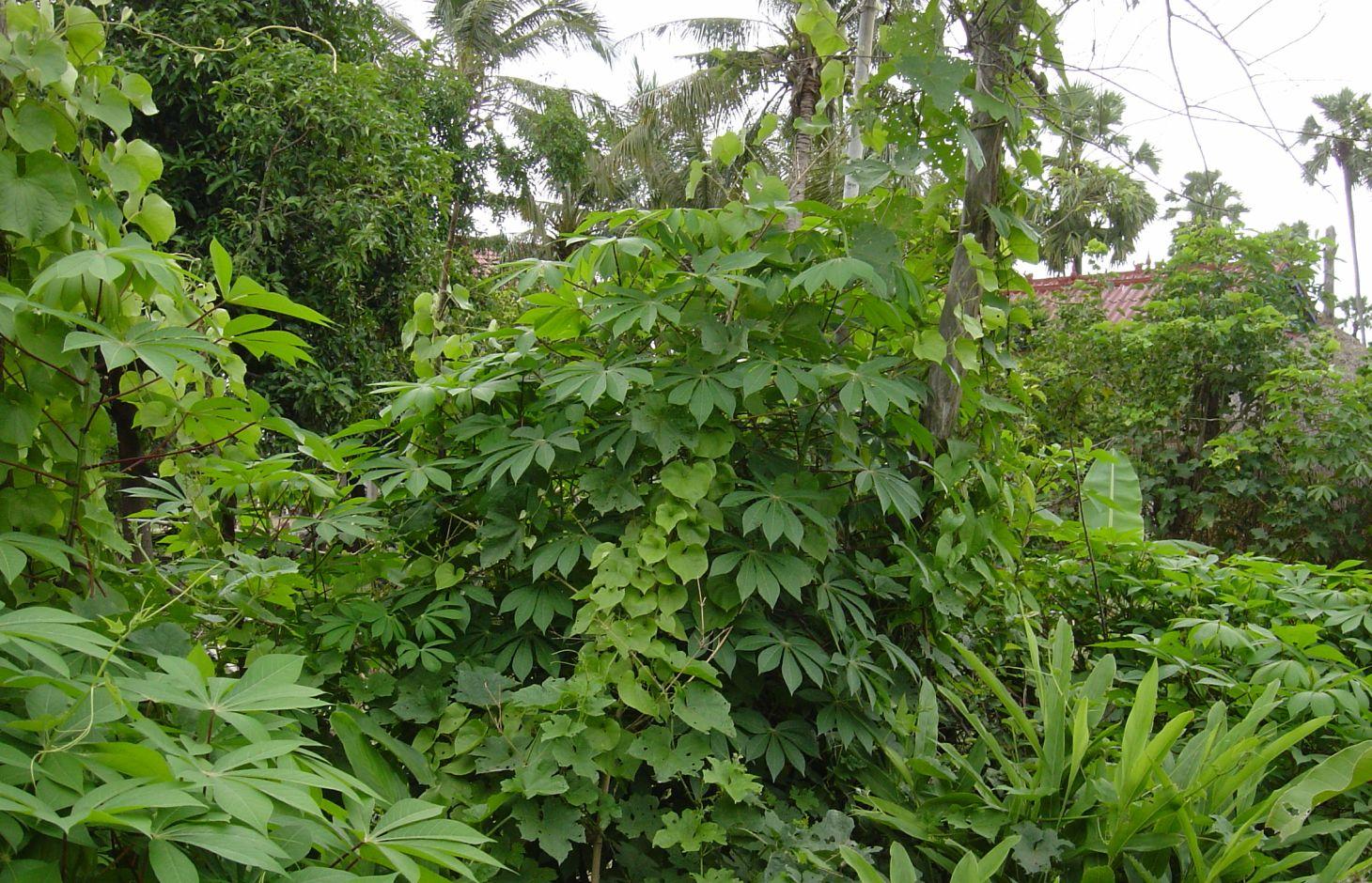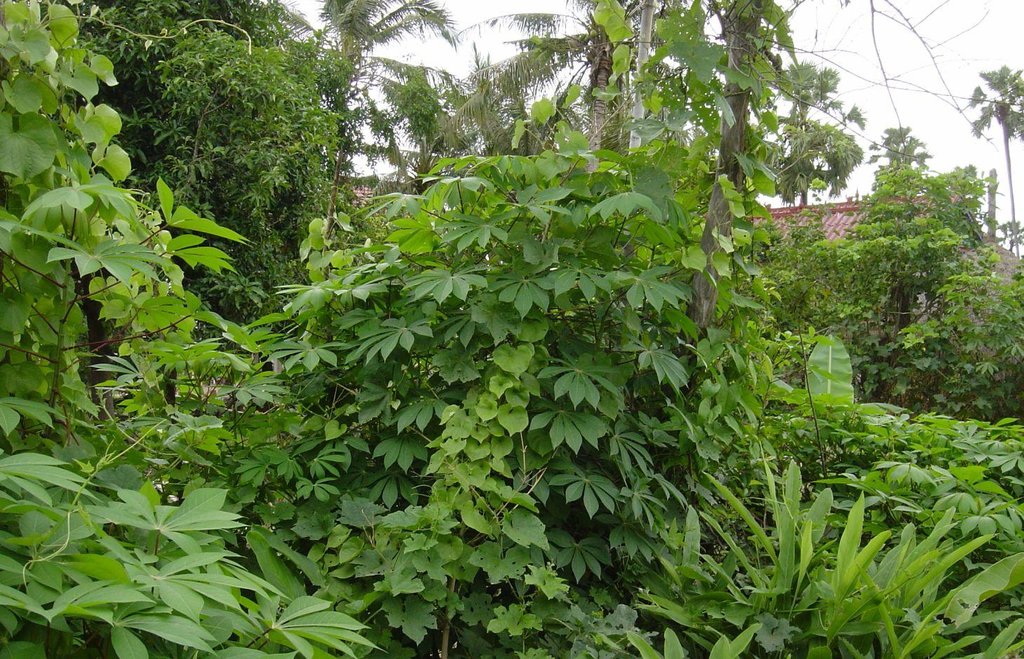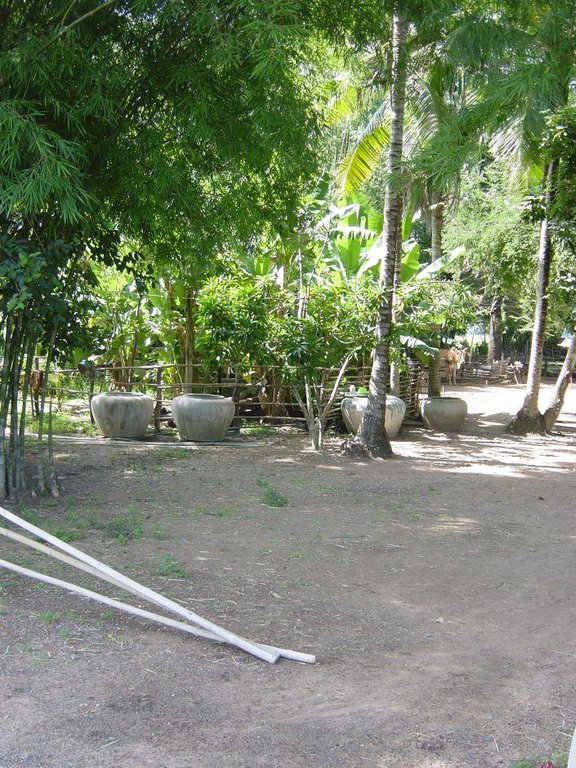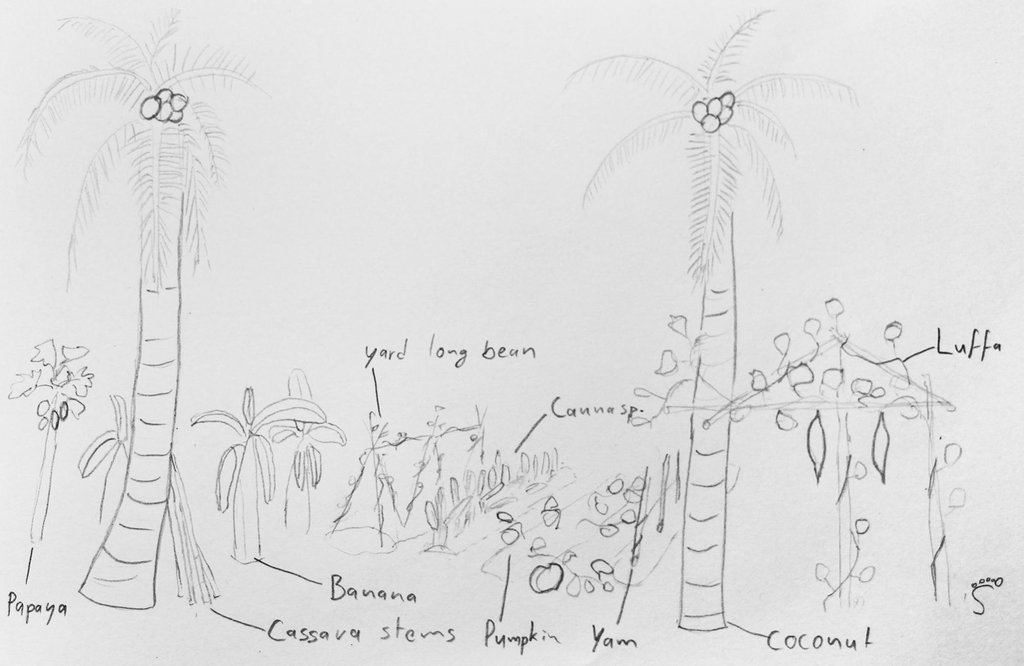Home gardens for consumption and cash crop production [กัมพูชา]
- ผู้สร้างสรรค์:
- การอัพเดท:
- ผู้รวบรวม: Stefan Graf
- ผู้เรียบเรียง: –
- ผู้ตรวจสอบ: Deborah Niggli, Alexandra Gavilano
ច្បារដំណាំ (Khmer)
technologies_1628 - กัมพูชา
ดูส่วนย่อย
ขยายทั้งหมด ย่อทั้งหมด1. ข้อมูลทั่วไป
1.2 รายละเอียดที่ติดต่อได้ของผู้รวบรวมและองค์กรที่เกี่ยวข้องในการประเมินและการจัดเตรียมทำเอกสารของเทคโนโลยี
ผู้เชี่ยวชาญ SLM:
Khun Lean Hak
SOFDEC/LAREC, www.sofdec.com
กัมพูชา
1.3 เงื่อนไขการใช้ข้อมูลที่ได้บันทึกผ่านทาง WOCAT
ผู้รวบรวมและวิทยากรหลักยอมรับเงื่อนไขเกี่ยวกับการใช้ข้อมูลที่ถูกบันทึกผ่านทาง WOCAT:
ใช่
1.4 การเปิดเผยเรื่องความยั่งยืนของเทคโนโลยีที่ได้อธิบายไว้
เทคโนโลยีที่ได้อธิบายไว้นี้เป็นปัญหาของความเสื่อมโทรมโทรมของที่ดินหรือไม่ จึงไม่ได้รับการยอมรับว่าเป็นเทคโนโลยีเพื่อการจัดการที่ดินอย่างยั่งยืน:
ไม่ใช่
2. การอธิบายลักษณะของเทคโนโลยี SLM
2.1 การอธิบายแบบสั้น ๆ ของเทคโนโลยี
คำจำกัดความของเทคโนโลยี:
Home gardens, containing tree, shrub, herbs, vine, tuber layers as well as poultry, produce food for household consumption as well as an additional income.
2.2 การอธิบายแบบละเอียดของเทคโนโลยี
คำอธิบาย:
Home gardens are a traditional setting in Cambodia, where they appear around nearly each house. All the seven layers of production occur, with a tree canopy, lower trees, shrubs, herbs, a soil cover, roots and tubers as well as a climbing layer, but not all layers can be found in each garden. The overlapping production allows a high productivity on a small area, and the trees/canopy provide a comfortable microclimate for both humans and livestock. The products of the home gardens are consumed by the family, surplus is given to neighbours or sold, and provide an additional income. One or more of the crops are produced in bigger amounts to serve as a cash crop. It can be coconuts close to the city, mangoes that are processed, sugarcane or vegetables like winged beans for the market, bamboo for handicrafts or constructions. Poultry is free ranging in the home gardens, thus when short annual plants like water spinach are planted they are protected with bamboo or net fences. The poultry, mostly chicken, but as well ducks, Muscovy ducks, and others, forages in the waste and eats bugs and worms.
The home gardens are planted to produce food, to provide additional income source and assure a comfortable microclimate. Medicinal plants, as well as plants for handicrafts like bamboo, are grown in the home gardens. Due to a lack of labour availability on the farms, the gardens are only poorly maintained. Some NGOs try to implement the production of more annual crops in the home gardens, but fail due to this constraint and the fact that leafy vegetables are collected from the wild during the wet season.
When a new house is built, canopy trees like coconuts or sugar palms are planted, sometimes following a square pattern, with other trees in between. In other gardens, no pattern can be found, as trees are planted more randomly, or left growing on their own. The seedlings growing in and around trash piles are transplanted to more suitable places, sometimes seedlings from grafted varieties are bought from the market.
Mainly annual crops, like yam, are fertilized with cow manure or compost before the sowing. Due to a lack of irrigation water, most farmers only grow annuals during the wet season. During the dry season, the vegetables are bought from other provinces or countries.
The analysed area is flat (slope < 2%), tropic (dry and wet season), and the soils are mostly sandy or loamy. The soils on the fields contain little organic matter (low soil fertility, acidification, small amount of cattle, area has been deforested a long time ago) and the groundwater table is rather high (2 m below soil level during the dry season, on the surface during the wet season).
Due to climate change, the rainfalls are more erratic, temperatures rise and droughts are more recurrent. Rice is the predominant crop grown in the area, since it serves as staple food (mix subsistence and commercial activities). Rice is often grown in monocultures and harvested once a year. Once the rice is harvested (dry season), some farmer release cattle to the paddy fields to eat the straw and weeds.
As an addition to rice, most land users grow vegetable and fruits in home gardens (subsistence) and complement their income by producing handicrafts or through off-farm income / remittances from family members working in other places. Gathering of wild food (plants, animals, and mushrooms) is also of importance for the diet. The increasing migration rate (the young generation leaves the villages to work in the cities, garment industry or abroad) results in a decrease of available labour force in the area that has detrimental effects on the agricultural activities. Furthermore, the civil war in the 1970s (Khmer Rouge) led to the loss of agricultural knowledge that different NGOs try to re-establish.
2.3 รูปภาพของเทคโนโลยี
2.5 ประเทศภูมิภาค หรือสถานที่ตั้งที่เทคโนโลยีได้นำไปใช้และได้รับการครอบคลุมโดยการประเมินนี้
ประเทศ:
กัมพูชา
ภูมิภาค/รัฐ/จังหวัด:
Kampong Chhnang
ระบุการกระจายตัวของเทคโนโลยี:
- กระจายไปอย่างสม่ำเสมอในพื้นที่
If precise area is not known, indicate approximate area covered:
- 10-100 ตร.กม.
แสดงความคิดเห็น:
There is a smooth transition between home gardens and orchards, as well as between home gardens and commercial garden. Thus a quantification of the area is difficult. But around 10 % of the village areas are used as home gardens.
2.6 วันที่การดำเนินการ
ถ้าไม่รู้ปีที่แน่นอน ให้ระบุวันที่โดยประมาณ:
- มากกว่า 50 ปี (แบบดั้งเดิม)
2.7 คำแนะนำของเทคโนโลยี
ให้ระบุว่าเทคโนโลยีถูกแนะนำเข้ามาอย่างไร:
- เป็นส่วนหนึ่งของระบบแบบดั้งเดิมที่ทำก้นอยู่ (> 50 ปี)
ความคิดเห็น (ประเภทของโครงการ เป็นต้น) :
There have always been home gardens. There is a lot of research carried out, with species and varieties spreading among farmers. Some NGOs also try to implement the production of more annual vegetables in the home gardens, but they are abandoned as soon as the NGOs leave.
3. การจัดประเภทของเทคโนโลยี SLM
3.1 วัตถุประสงค์หลักของเทคโนโลยี
- ปรับปรุงการผลิตให้ดีขึ้น
- สร้างผลกระทบทางด้านเศรษฐกิจที่เป็นประโยชน์
3.2 ประเภทของการใช้ที่ดินในปัจจุบันที่ได้นำเทคโนโลยีไปใช้
Land use mixed within the same land unit:
ใช่
Specify mixed land use (crops/ grazing/ trees):
- วนเกษตร (Agroforestry)

พื้นที่ปลูกพืช
- การปลูกพืชล้มลุกอายุปีเดียว
- การปลูกพืชยืนต้นที่ไม่มีเนื้อไม้
- การปลูกไม้ยืนต้น ไม้พุ่ม
Annual cropping - Specify crops:
- cereals - rice (upland)
- root/tuber crops - sweet potatoes, yams, taro/cocoyam, other
- root/tuber crops - cassava
- vegetables - melon, pumpkin, squash or gourd
Perennial (non-woody) cropping - Specify crops:
- banana/plantain/abaca
Tree and shrub cropping - Specify crops:
- citrus
- coconut (fruit, coir, leaves, etc.)
- fruits, other
- mango, mangosteen, guava
- papaya
ระบุ:
Longest growing period in days: 210, Longest growing period from month to month: June to December

ป่า/พื้นที่ทำไม้
Type of tree:
- Bamboo bamboo
แสดงความคิดเห็น:
Major land use problems (compiler’s opinion): Overgrazing, low soil fertility, sandy soils, monocultures, soil left bare after ploughing, wind and dust storms, climate change.
Major land use problems (land users’ perception): Lack of water in the dry season, low soil fertility.
Type of cropping system and major crops comments: Cash and food crops depend highly on personal preferences.
3.4 การใช้น้ำ
การใช้น้ำของที่ดินที่มีการใช้เทคโนโลยีอยู่:
- น้ำฝนร่วมกับการชลประทาน
3.5 กลุ่ม SLM ที่ตรงกับเทคโนโลยีนี้
- การปลูกป่าร่วมกับพืช
- การเลี้ยงผึ้ง การเพาะเลี้ยงสัตว์น้ำ สัตว์ปีก ฟาร์มกระต่าย ฟาร์มหนอนไหม
- สวนครัว
3.6 มาตรการ SLM ที่ประกอบกันเป็นเทคโนโลยี

มาตรการอนุรักษ์ด้วยวิธีพืช
- V1: ต้นไม้และพุ่มไม้คลุมดิน
- V2: หญ้าและไม้ยืนต้น
แสดงความคิดเห็น:
Type of vegetative measures: scattered / dispersed
3.7 รูปแบบหลักของการเสื่อมโทรมของที่ดินที่ได้รับการแก้ไขโดยเทคโนโลยี

การกัดกร่อนของดินโดยลม
- Et (Loss of topsoil): การสูญเสียดินชั้นบน

การเสื่อมโทรมของดินทางด้านเคมี
- Cn (Fertility decline): ความอุดมสมบูรณ์และปริมาณอินทรียวัตถุในดินถูกทำให้ลดลงไป (ไม่ได้เกิดจากสาเหตุการกัดกร่อน)
- Ca (Acidification): การเกิดกรด

การเสื่อมโทรมของน้ำ
- Ha (Aridification): การเกิดความแห้งแล้ง
- Hg (Change in groundwater): การเปลี่ยนแปลงของน้ำบาดาลหรือระดับน้ำในแอ่งน้ำบาดาล
แสดงความคิดเห็น:
Main causes of degradation: soil management (Soil left bare after ploughing), crop management (annual, perennial, tree/shrub) (Monocultures of annual crops (rice))
Secondary causes of degradation: overgrazing (Uncontrolled grazing on fallow fields), change in temperature (More hot days, climate change), wind storms / dust storms (Human induced dust storms, wind storms due to climate change.), droughts (Climate change), labour availability (High migration rates), education, access to knowledge and support services (Agricultural knowledge lost during the Khmer Rouge Regime.), war and conflicts (Agricultural knowledge lost during the Khmer Rouge Regime.)
3.8 การป้องกัน การลดลง หรือการฟื้นฟูความเสื่อมโทรมของที่ดิน
ระบุเป้าหมายของเทคโนโลยีกับความเสื่อมโทรมของที่ดิน:
- ป้องกันความเสื่อมโทรมของที่ดิน
- ลดความเสื่อมโทรมของดิน
4. ข้อมูลจำเพาะด้านเทคนิค กิจกรรมการนำไปปฏิบัติใช้ ปัจจัยนำเข้า และค่าใช้จ่าย
4.1 แบบแปลนทางเทคนิคของเทคโนโลยี
ข้อมูลจำเพาะด้านเทคนิค (แบบแปลนทางเทคนิคของเทคโนโลยี):
Example of a homegarden with different layers. Coconut palms present the top layer, different vines grow on trellises, bananas and a dwarf papaya form an intermediate layer, pumpkins form the soil cover and Canna represents the edible roots. Many edible wild plants would grow by themselves between the planted ones, and would also be consumed.
Kampong Chhnang
Date: 2014
Technical knowledge required for field staff / advisors: moderate
Technical knowledge required for land users: moderate (Each garden is different.)
Main technical functions: improvement of ground cover, increase in organic matter, increase in nutrient availability (supply, recycling,…), increase of biomass (quantity), promotion of vegetation species and varieties (quality, eg palatable fodder), spatial arrangement and diversification of land use
Secondary technical functions: water harvesting / increase water supply, improvement of water quality, buffering / filtering water, sediment retention / trapping, sediment harvesting, reduction in wind speed
Scattered / dispersed
Vegetative material: T : trees / shrubs, F : fruit trees / shrubs, C : perennial crops
Number of plants per (ha): n/a
Fruit trees / shrubs species: Sugar palm, coconut, mango, custard apple, bananas, limes.
Perennial crops species: Lemon grass, bamboo.
Other species: Eggplants, winged beans, yard long beans, pumpkins, cucumbers.
ผู้เขียน:
Stefan Graf, Switzerland
4.2 ข้อมูลทั่วไปเกี่ยวกับการคำนวณปัจจัยนำเข้าและค่าใช้จ่าย
ระบุค่าเฉลี่ยของค่าจ้างในการจ้างแรงงานต่อวัน:
5.00
4.3 กิจกรรมเพื่อการจัดตั้ง
| กิจกรรม | Timing (season) | |
|---|---|---|
| 1. | Planting of the selected trees and other plants. | Whole year |
4.4 ค่าใช้จ่ายของปัจจัยนำเข้าที่จำเป็นสำหรับการจัดตั้ง
| ปัจจัยนำเข้า | หน่วย | ปริมาณ | ค่าใช้จ่ายต่อหน่วย | ค่าใช้จ่ายทั้งหมดต่อปัจจัยนำเข้า | %ของค่าใช้จ่ายที่ก่อให้เกิดขึ้นโดยผู้ใช้ที่ดิน | |
|---|---|---|---|---|---|---|
| แรงงาน | Labour | 1.0 | 10.0 | 10.0 | 100.0 | |
| อุปกรณ์ | Tools | 1.0 | 20.0 | 20.0 | 100.0 | |
| วัสดุด้านพืช | seeds | 1.0 | 5.0 | 5.0 | 100.0 | |
| วัสดุด้านพืช | seedlings | 1.0 | 45.0 | 45.0 | 100.0 | |
| ค่าใช้จ่ายทั้งหมดของการจัดตั้งเทคโนโลยี | 80.0 | |||||
| Total costs for establishment of the Technology in USD | 80.0 | |||||
4.5 การบำรุงรักษาสภาพหรือกิจกรรมที่เกิดขึ้นเป็นประจำ
| กิจกรรม | ช่วงระยะเวลา/ความถี่ | |
|---|---|---|
| 1. | Harvesting | Depends on the size of the garden and the crops. |
| 2. | Planting and fertilizing | Depends on the farmers' preference for a given crop |
4.6 ค่าใช้จ่ายของปัจจัยนำเข้าและกิจกรรมที่เกิดขึ้นเป็นประจำที่ต้องการการบำรุงรักษา (ต่อปี)
| ปัจจัยนำเข้า | หน่วย | ปริมาณ | ค่าใช้จ่ายต่อหน่วย | ค่าใช้จ่ายทั้งหมดต่อปัจจัยนำเข้า | %ของค่าใช้จ่ายที่ก่อให้เกิดขึ้นโดยผู้ใช้ที่ดิน | |
|---|---|---|---|---|---|---|
| แรงงาน | labour | 1.0 | 60.0 | 60.0 | 100.0 | |
| วัสดุด้านพืช | seeds | 1.0 | 3.0 | 3.0 | 100.0 | |
| ค่าใช้จ่ายทั้งหมดของการบำรุงรักษาสภาพเทคโนโลยี | 63.0 | |||||
| Total costs for maintenance of the Technology in USD | 63.0 | |||||
แสดงความคิดเห็น:
Machinery/ tools: Depending on the planted crops a knife, hatchet, spate and hoe.
The costs were calculated for 2014 for an “average” home garden that is newly established on a cleared land. It is not based on one case study, but on discussions with many farmers.
4.7 ปัจจัยสำคัญที่สุดที่มีผลกระทบต่อค่าใช้จ่าย
ปัจจัยสำคัญที่สุดที่มีผลกระทบต่อค่าใช้จ่ายต่างๆ:
The labour is the most expensive in the home gardens. This is problematic as the labour availability is decreasing due to high migration rates.
5. สิ่งแวดล้อมทางธรรมชาติและของมนุษย์
5.1 ภูมิอากาศ
ฝนประจำปี
- < 250 ม.ม.
- 251-500 ม.ม.
- 501-750 ม.ม.
- 751-1,000 ม.ม.
- 1,001-1,500 ม.ม.
- 1,501-2,000 ม.ม.
- 2,001-3,000 ม.ม.
- 3,001-4,000 ม.ม.
- > 4,000 ม.ม.
ข้อมูลจำเพาะ/ความคิดเห็นเรื่องปริมาณน้ำฝน:
1486.45 mm 2013 in Kampong Chhnang
เขตภูมิอากาศเกษตร
- กึ่งชุ่มชื้น
Thermal climate class: tropics. 27-35°C
5.2 สภาพภูมิประเทศ
ค่าเฉลี่ยความลาดชัน:
- ราบเรียบ (0-2%)
- ลาดที่ไม่ชัน (3-5%)
- ปานกลาง (6-10%)
- เป็นลูกคลื่น (11-15%)
- เป็นเนิน (16-30%)
- ชัน (31-60%)
- ชันมาก (>60%)
ธรณีสัณฐาน:
- ที่ราบสูง/ที่ราบ
- สันเขา
- ไหล่เขา
- ไหล่เนินเขา
- ตีนเนิน
- หุบเขา
ระดับความสูง:
- 0-100 เมตร
- 101-500 เมตร
- 501-1,000 เมตร
- 1,001-1,500 เมตร
- 1,501-2,000 เมตร
- 2,001-2,500 เมตร
- 2,501-3,000 เมตร
- 3,001-4,000 เมตร
- > 4,000 เมตร
5.3 ดิน
ค่าเฉลี่ยความลึกของดิน:
- ตื้นมาก (0-20 ซ.ม.)
- ตื้น (21-50 ซ.ม.)
- ลึกปานกลาง (51-80 ซ.ม.)
- ลึก (81-120 ซ.ม.)
- ลึกมาก (>120 ซ.ม.)
เนื้อดิน (ดินชั้นบน):
- ปานกลาง (ดินร่วน ทรายแป้ง)
เนื้อดินล่าง (> 20 ซ.ม.ต่ำจากผิวดิน):
- ปานกลาง (ดินร่วน ทรายแป้ง)
อินทรียวัตถุในดิน:
- ปานกลาง (1-3%)
- ต่ำ (<1%)
(ถ้ามี) ให้แนบคำอธิบายเรื่องดินแบบเต็มหรือระบุข้อมูลที่มีอยู่ เช่น ชนิดของดิน ค่า pH ของดินหรือความเป็นกรดของดิน ความสามารถในการแลกเปลี่ยนประจุบวก ไนโตรเจน ความเค็ม เป็นต้น:
Home gardens are used in the whole of Kampong Chhnang Province, even in urban areas.
5.4 ความเป็นประโยชน์และคุณภาพของน้ำ
ระดับน้ำใต้ดิน:
<5 เมตร
น้ำไหลบ่าที่ผิวดิน:
ไม่ดีหรือไม่มีเลย
คุณภาพน้ำ (ที่ยังไม่ได้บำบัด):
เป็นน้ำเพื่อการดื่มที่ไม่ดี (จำเป็นต้องได้รับการบำบัด)
ความคิดเห็นและข้อมูลจำเพาะเพิ่มเติมเรื่องคุณภาพและปริมาณน้ำ:
Ground water table: during dry season
Availability of surface water: during dry season
Water quality: People use it for drinking after filtering or boiling.
5.5 ความหลากหลายทางชีวภาพ
ความหลากหลายทางชนิดพันธุ์:
- ต่ำ
ความคิดเห็นและข้อมูลจำเพาะเพิ่มเติมของความหลากหลายทางชีวภาพ:
Only degraded forests are in the area
5.6 ลักษณะของผู้ใช้ที่ดินที่นำเทคโนโลยีไปปฏิบัติใช้
แนวทางการตลาดของระบบการผลิต:
- mixed (subsistence/ commercial)
รายได้ที่มาจากนอกฟาร์ม:
- 10-50% ของรายได้ทั้งหมด
ระดับของความมั่งคั่งโดยเปรียบเทียบ:
- จน
- พอมีพอกิน
เป็นรายบุคคล/ครัวเรือน:
- เป็นรายบุคคล/ครัวเรือน
ระดับของการใช้เครื่องจักรกล:
- งานที่ใช้แรงกาย
เพศ:
- หญิง
- ชาย
ระบุลักษณะอื่นๆที่เกี่ยวข้องของผู้ใช้ที่ดิน:
Land users applying the Technology are mainly common / average land users
Population density: 10-50 persons/km2
Annual population growth: 0.5% - 1%
Off-farm income specification: Handicraft, remittances and factory work
Different crops are used as cash crops.
5.7 Average area of land used by land users applying the Technology
- < 0.5 เฮกตาร์
- 0.5-1 เฮกตาร์
- 1-2 เฮกตาร์
- 2-5 เฮกตาร์
- 5-15 เฮกตาร์
- 15-50 เฮกตาร์
- 50-100 เฮกตาร์
- 100-500 เฮกตาร์
- 500-1,000 เฮกตาร์
- 1,000-10,000 เฮกตาร์
- >10,000 เฮกตาร์
พิจารณาว่าเป็นขนาดเล็ก กลาง หรือขนาดใหญ่ (ซึ่งอ้างอิงถึงบริบทระดับท้องถิ่น):
- ขนาดเล็ก
5.8 กรรมสิทธิ์ในที่ดิน สิทธิในการใช้ที่ดินและสิทธิในการใช้น้ำ
กรรมสิทธิ์ในที่ดิน:
- เป็นแบบชุมชนหรือหมู่บ้าน
- รายบุคคล ไม่ได้รับสิทธิครอบครอง
สิทธิในการใช้ที่ดิน:
- เกี่ยวกับชุมชน (ถูกจัดระเบียบ)
- รายบุคคล
สิทธิในการใช้น้ำ:
- เข้าถึงได้แบบเปิด (ไม่ได้จัดระเบียบ)
แสดงความคิดเห็น:
Land users have a title that is not recognized by the state
5.9 การเข้าถึงบริการและโครงสร้างพื้นฐาน
สุขภาพ:
- จน
- ปานกลาง
- ดี
การศึกษา:
- จน
- ปานกลาง
- ดี
ความช่วยเหลือทางด้านเทคนิค:
- จน
- ปานกลาง
- ดี
การจ้างงาน (เช่น ภายนอกฟาร์ม):
- จน
- ปานกลาง
- ดี
ตลาด:
- จน
- ปานกลาง
- ดี
พลังงาน:
- จน
- ปานกลาง
- ดี
ถนนและการขนส่ง:
- จน
- ปานกลาง
- ดี
น้ำดื่มและการสุขาภิบาล:
- จน
- ปานกลาง
- ดี
บริการด้านการเงิน:
- จน
- ปานกลาง
- ดี
6. ผลกระทบและสรุปคำบอกกล่าว
6.1 ผลกระทบในพื้นที่ดำเนินการ (On-site) จากการใช้เทคโนโลยี
ผลกระทบทางด้านเศรษฐกิจและสังคม
การผลิต
การผลิตพืชผล
การผลิตพืชที่ใช้เลี้ยงปศุสัตว์
การผลิตไม้
การเสี่ยงต่อความล้มเหลวในการผลิต
ความหลากหลายของผลิตภัณฑ์
ความเป็นประโยชน์และคุณภาพของน้ำ
การมีน้ำดื่มไว้ให้ใช้
แสดงความคิดเห็น/ระบุ:
Bioremediation of groundwater.
ความต้องการน้ำจากการชลประทาน
แสดงความคิดเห็น/ระบุ:
if more perennials (trees) are planted.
รายได้และค่าใช้จ่าย
ความหลากหลายของแหล่งผลิตรายได้
แสดงความคิดเห็น/ระบุ:
Otherwise only rice is grown. Bamboo is used for handicraft.
ภาระงาน
แสดงความคิดเห็น/ระบุ:
Depending on crops. Most home garden crops have an excellent cost/benefit ratio.
ผลกระทบด้านสังคมวัฒนธรรมอื่น ๆ
ความมั่นคงด้านอาหาร / พึ่งตนเองได้
สถานการณ์ด้านสุขภาพ
แสดงความคิดเห็น/ระบุ:
Together with food collected from the wild, improves the mainly rice based dishes.
contribution to human well-being
แสดงความคิดเห็น/ระบุ:
Increased income, income diversification, food security, food diversification
ผลกระทบด้านนิเวศวิทยา
วัฐจักรน้ำหรือน้ำบ่า
คุณภาพน้ำ
แสดงความคิดเห็น/ระบุ:
Bioremediaiton of groundwater.
ดิน
สิ่งปกคลุมดิน
แสดงความคิดเห็น/ระบุ:
Permanent soil cover
การหมุนเวียนและการเติมของธาตุอาหาร
แสดงความคิดเห็น/ระบุ:
Nutrients from groundwater are returned to the cycle.
อินทรียวัตถุในดิน/ต่ำกว่าดินชั้น C
แสดงความคิดเห็น/ระบุ:
If the leaves are not burnt.
ความหลากหลายทางชีวภาพของพืชและสัตว์
มวลชีวภาพ/เหนือดินชั้น C
ความหลากหลายทางชีวภาพของพืช
ความหลากหลายทางชีวภาพของสัตว์
ลดความเสี่ยงของภัยพิบัติ
ความเร็วของลม
6.2 ผลกระทบนอกพื้นที่ดำเนินการ (Off-site) จากการใช้เทคโนโลยี
การเกิดมลพิษในน้ำบาดาลหรือแม่น้ำ
แสดงความคิดเห็น/ระบุ:
Bioremediation of groundwater.
ความสามารถต้านทานการเปลี่ยนแปลง / ความสามารถในการคัดกรอง
แสดงความคิดเห็น/ระบุ:
Bioremediation of groundwater.
ตะกอนที่ถูกพัดพามาโดยลม
6.3 การเผชิญและความตอบสนองของเทคโนโลยีต่อการเปลี่ยนแปลงสภาพภูมิอากาศที่ค่อยเป็นค่อยไป และสภาพรุนแรงของภูมิอากาศ / ภัยพิบัติ (ที่รับรู้ได้โดยผู้ใช้ที่ดิน)
การเปลี่ยนแปลงสภาพภูมิอากาศที่ค่อยเป็นค่อยไป
การเปลี่ยนแปลงสภาพภูมิอากาศที่ค่อยเป็นค่อยไป
| ฤดู | increase or decrease | เทคโนโลยีมีวิธีการรับมืออย่างไร | |
|---|---|---|---|
| อุณหภูมิประจำปี | เพิ่มขึ้น | ดี |
สภาพรุนแรงของภูมิอากาศ (ภัยพิบัติ)
ภัยพิบัติทางอุตุนิยมวิทยา
| เทคโนโลยีมีวิธีการรับมืออย่างไร | |
|---|---|
| พายุฝนประจำท้องถิ่น | ดี |
| พายุลมประจำท้องถิ่น | ไม่ทราบ |
ภัยพิบัติจากสภาพภูมิอากาศ
| เทคโนโลยีมีวิธีการรับมืออย่างไร | |
|---|---|
| ภัยจากฝนแล้ง | ดี |
ภัยพิบัติจากน้ำ
| เทคโนโลยีมีวิธีการรับมืออย่างไร | |
|---|---|
| น้ำท่วมตามปกติ (แม่น้ำ) | ไม่ทราบ |
ผลลัพธ์ตามมาที่เกี่ยวข้องกับภูมิอากาศอื่น ๆ
ผลลัพธ์ตามมาที่เกี่ยวข้องกับภูมิอากาศอื่น ๆ
| เทคโนโลยีมีวิธีการรับมืออย่างไร | |
|---|---|
| ช่วงการปลูกพืชที่ลดลงมา | ดี |
6.4 การวิเคราะห์ค่าใช้จ่ายและผลประโยชน์ที่ได้รับ
ผลประโยชน์ที่ได้รับเปรียบเทียบกับค่าใช้จ่ายในการจัดตั้งเป็นอย่างไร (จากมุมมองของผู้ใช้ที่ดิน)
ผลตอบแทนระยะสั้น:
ด้านบวก
ผลตอบแทนระยะยาว:
ด้านบวกอย่างมาก
ผลประโยชน์ที่ได้รับเปรียบเทียบกับค่าใช้จ่ายในการบำรุงรักษาหรือต้นทุนที่เกิดขึ้นซ้ำอีก เป็นอย่างไร (จากมุมมองของผู้ใช้ที่ดิน)
ผลตอบแทนระยะสั้น:
ด้านบวกอย่างมาก
ผลตอบแทนระยะยาว:
ด้านบวกอย่างมาก
6.5 การปรับตัวของเทคโนโลยี
- > 50%
Of all those who have adopted the Technology, how many did so spontaneously, i.e. without receiving any material incentives/ payments?
- 91-100%
แสดงความคิดเห็น:
Nearly every farm has at least a small patch of land with some fruits/trees/vegetables
100% of land user families have adopted the Technology without any external material support. As almost every farm has a small home garden the number of farmer families could not be specified. Nearly everybody already has a small home garden. Species and varieties are spontaneously spreading between farms
6.7 จุดแข็ง / ข้อได้เปรียบ / โอกาสของเทคโนโลยี
| จุดแข็ง / ข้อได้เปรียบ / โอกาสในทัศนคติของผู้ใช้ที่ดิน |
|---|
| To produce fruits and vegetables for home consumption |
| Many types of fruits and vegetables can be produced on a small area of land, for home consumption and to sell the surplus |
| The home gardens are close to the houses, all the members of the family can help, and it is possible to look at the house at the same time |
| จุดแข็ง / ข้อได้เปรียบ / โอกาสในทัศนคติของผู้รวบรวมหรือวิทยากรหลัก |
|---|
| Increased food security and health |
| Diversification of income sources |
| Improvement of the soil fertility where farmers use compost |
6.8 จุดอ่อน / ข้อเสียเปรียบ / ความเสี่ยงของเทคโนโลยีและวิธีการแก้ไข
| จุดอ่อน / ข้อเสียเปรียบ / ความเสี่ยงในทัศนคติของผู้ใช้ที่ดิน | มีวิธีการแก้ไขได้อย่างไร |
|---|---|
| Lack of water for irrigation | Build household ponds |
| Insects are attracted to the crops, and spread when crops are grown together | Use integrated pest management |
| Prices sometimes drop for seasonal crops, like mangoes, and farmers cannot sell the crop | Process the fruits (e.g. drying) so they can be preserved |
| จุดอ่อน / ข้อเสียเปรียบ / ความเสี่ยงในทัศนคติของผู้รวบรวมหรือวิทยากรหลัก | มีวิธีการแก้ไขได้อย่างไร |
|---|---|
| Lack of good varieties and selection, lack of knowledge about grafting fruit trees | Organize seed exchange, organize grafting and seed saving trainings |
| Lack of knowledge about fertilization, not all farmers know about the benefits of compost or manure. Leaves are often burned in the home gardens | Provide composting and mulching training |
7. การอ้างอิงและการเชื่อมต่อ
7.1 วิธีการและแหล่งข้อมูล
- ไปเยี่ยมชมภาคสนาม การสำรวจพื้นที่ภาคสนาม
- การสัมภาษณ์กับผู้ใช้ที่ดิน
วันที่เก็บรวบรวมข้อมูล(ภาคสนาม) :
09/07/2014
7.2 การอ้างอิงถึงสิ่งตีพิมพ์
หัวข้อ, ผู้เขียน, ปี, หมายเลข ISBN:
Kumar & Nair (Ed.). 2006. Tropical Homegardens. A time tested example of sustainable agroforestry. Dordrecht: Springer
ชื่อเรื่อง ผู้เขียน ปี ISBN:
http://library.uniteddiversity.coop/Permaculture/Agroforestry/Tropical_Homegardens-A_Time_Tested_Example_of_Sustainable_Agroforestry.pdf
ลิงก์และโมดูล
ขยายทั้งหมด ย่อทั้งหมดลิงก์
ไม่มีลิงก์
โมดูล
ไม่มีโมดูล





